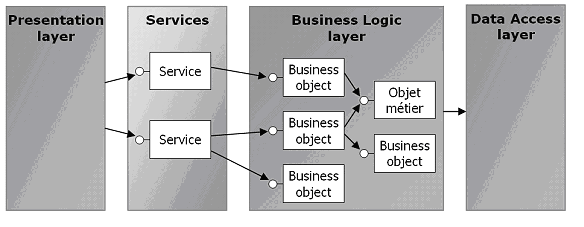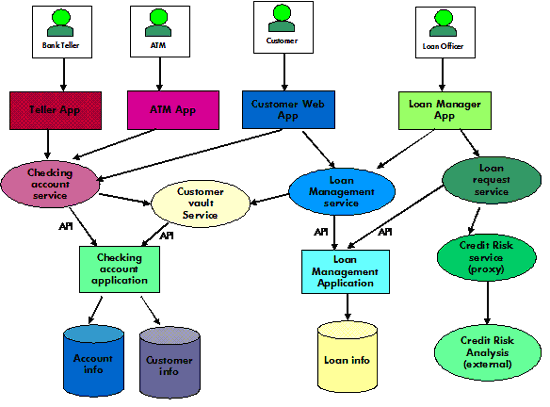 Abstract: This paper provides an overview of service-oriented architecture (SOA) by providing a definition, examples and diagrams. The concept is analyzed through the use of several sources and then applied to our own internal shipping application here at KnowToys Inc.
Abstract: This paper provides an overview of service-oriented architecture (SOA) by providing a definition, examples and diagrams. The concept is analyzed through the use of several sources and then applied to our own internal shipping application here at KnowToys Inc.
Introduction: SOA is perceived to be a tremendous tool for IT for many reasons, though fundamentally it is inherent across almost all areas of business that the goals achieved by working inward as opposed to outward are ideal under any circumstances, and so the focus of my analysis led me towards this benefit gained through SOA perhaps more than any other. The practice of acquisition and consolidation carries along with it some unavoidable tasks dealing with the merging of metadata into current systems, ensuring customers are able to be serviced in short time, and providing users the tools necessary to allow for minimal drops in productivity, quality or service levels. SOA solutions are built to mitigate these unavoidable challenges.
Outside the realm of transition though, there are many applicable uses for SOA applications throughout the business world when also dealing with pre-existing conditions. Areas are identified where instead of a user working with several applications interacting with even more data repositories, an application is built that brings these many functions under one roof. Customers may use SOA products to conduct business that before was handled in person, or the website that used to perform a limited number of services becomes expanded to include twice as many. With these examples in mind, I perceive the crux of SOA to be just as much a frame of mind as it is a technology, with the emphasis on finding more uses for something that is already present as opposed to creating something new.
– – –
The ability to “respond more quickly to business needs” (Unknown, 2006) is probably something that’s at the top of the list when executives are expressing how IT could help out the organization more in the future. Putting out fires and such, the technology division of an organization may have been able to do only so much as long as business decisions that affected operations flowed in from the outside. Service-oriented architecture flips this traditional arrangement with IT now becoming the origin of ideas for cost-savings and solutions to problems in the present and down the line. In essence SOA is, “designed to help IT managers attain the holy grail of enterprise application integration” (Clark, 2006).
An application becomes more a collection of other applications and solutions, and through this evolution the service-oriented architecture works for the sake of other technology, rather than the traditional process-based development carried out for the sake of automating a manual process. The SOA application acts as a service provider, and the development of it focuses on enabling the use of modules from different applications, supporting present and future technologies and ensuring scalability. What the user perceives is behind the GUI is actually nothing but a conduit linking several other things together. “Services behave as black boxes: they give an abstraction of the object model and only expose a reduced set of features, which reduces the interchanges between layers.” (Margueire, 2004)

In the above diagram we have two services through which requests are originated and fed through a number of business objects, how many depending on the nature of the request, and the data access layer is reached. An answer is sent back through however many objects as is necessary and to the user it appears as if the one service they are using had performed the task on its own, never knowing how many communications with underlying technologies were a part of it.
A service is being provided here having to do with information being sought and provided. “Corporate adoption of information as a service is the next leap into the SOA pond.” (Dzubeck, 2006) No longer just a matter of space, connectivity and quality, data access and the capability to manipulate it as needed is now a concept squarely on the side of hope and potential in terms of perception when it comes to executives in search of present and future performance. SOA allows for the creative and strategic minds in an organization to leverage the potential contained in its data like never before, with evermore the need to consolidate and use more and more, the ability to “create entire libraries of such services, which can then be used like electronic building blocks to speed application development.” (Duvall, 2006)
In the banking industry this has been the strategy, and with $1 billion (Martens, 2006) being spent by IBM in the coming year in SOA-related areas, it is sure to become a revenue generator for such firms for years to come. Consolidation in the banking industry is perhaps the most obvious place where SOA would thrive, as with every acquisition of a competitor, a merging of metadata and the need to use it immediately is paramount in hopes of retaining the inherited business already in place. Also, providing users the ability to pull up as much information as possible helps to sell a lot more over time, as SOA “can be used to reach into legacy applications that store customer bank accounts, mortgage info or credit card data and present the information in a single window.” (Duvall, 2006)

Service-oriented architecture protocol (SOAP) is involved in the communication from the above customer’s web application to the enterprise applications it interacts with, and is basically a messaging format that is widely used in XML documents. (Erl, 2004) This aspect is relevant to our shipping application as customers will be checking on the status of packages through our website, which is going to leverage our own databases as well as those of our delivery vendors. The relatively universal nature of SOAP is a plus, as rarely will customers experience errors.
Defining SOA isn’t as simple as other concepts, as the application changes from company to company, but with the banking example in mind, as well as our own shipping application, I would put it like this: A method of merging separate functions under the control of a technology, which then utilizes its access to the benefit of a user, customer and/or organization as a whole.
Our shipping application already constitutes an SOA in the sense that it pulls data from a couple different places that were previously divided (sales, accounting, shipping), and in expansion of our company over time, the range of functions is bound to grow. Already customers are able to check on the status of their orders, review a consolidated account history, pay their bill and order more products. As the amount of data we store grows, the potential for gain using SOA is great.
Conclusion: There are seemingly infinite opportunities within the IT world as it exists within every industry to leverage SOA for the better. With this evolution of technology and how it impacts commerce, the need for business savvy in the IT arena grows.
If IBM is pumping in a billion dollars this year towards SOA initiatives, it is prudent to pay attention to what happens in the years to come, as the opportunity to break away from the competition could materialize within this field.
References:
Dzubeck, Frank. 10/30/2006, Network World, Volume 23, Issue 42, p35, “SOA evolves with information services”, http://search.ebscohost.com/login.aspx?direct=true&db=cph&AN=22939759&loginpage=Login.asp&site=ehost-live
Unknown. Oct2006, CIO Insight, Issue 73, p73, “Service-Oriented Architecture”, http://search.ebscohost.com/login.aspx?direct=true&db=cph&AN=22885383&loginpage=Login.asp&site=ehost-live
Clark, Lindsay. 9/26/2006, Computer Weekly, p14, “SOA gathers pace in the enterprise”,http://search.ebscohost.com/login.aspx?direct=true&db=cph&AN=22910266&loginpage=Login.asp&site=ehost-live
Duvall, Mel. Oct2006, Baseline, Issue 64, p37-39, “Banking on SOA”, http://search.ebscohost.com/login.aspx?direct=true&db=cph&AN=22542647&loginpage=Login.asp&site=ehost-live
Martens, China. 10/9/2006, InfoWorld, Volume 28, Issue 42, p8-9, “IBM Reaffirms its Passion for SOA”, http://search.ebscohost.com/login.aspx?direct=true&db=cph&AN=22773313&loginpage=Login.asp&site=ehost-live
Havenstein, Heather. 10/9/2006, Computerworld, Volume 40, Issue 41, p6, “Incremental SOA Efforts Work for Clear Channel”, http://search.ebscohost.com/login.aspx?direct=true&db=cph&AN=22729958&loginpage=Login.asp&site=ehost-live
Erl, Thomas. 9/3/2004, http://www.phptr.com/articles/article.asp?p=336265&seqNum=3&rl=1
Secrist, Mark. January 2006, http://devresource.hp.com/drc/technical_white_papers/soa_concepts/index.jsp
Marguerie, Fabrice. January 2004, http://madgeek.com/Articles/SOA/EN/SOA-Softly.html
This was written by yours’ truly…last semester.

Holy fuck, no wonder you get As.
Lost points on this one because my references weren’t in alphabetical order. S.R., are you into hip-hop at all? I’m listening to Rhymefest, the latest album, the second half of this one is incredible…
This paper was a beast – the new semester started last friday, and I’m already insomniakified telling myself to pop a melatonin…Rome and Extras start up again this Sunday night.
Pingback: Dovetail Software Blogs : Daily Dovetail Links 2007-1-10